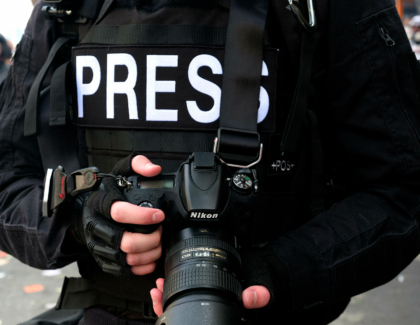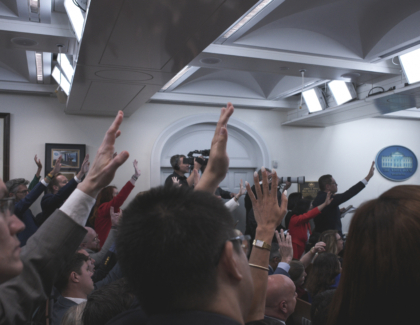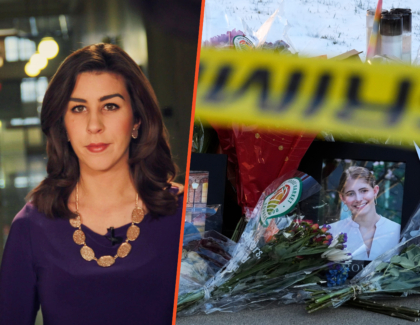Sign up for the daily CJR newsletter.
On Sunday afternoon, Kim Potter, a police officer in Brooklyn Center, a suburb of Minneapolis, shot and killed Daunte Wright, a twenty-year-old Black man, during a traffic stop. Minneapolis was already grappling with the ongoing trial of Derek Chauvin, the cop charged with murdering George Floyd in the city last summer; on Sunday night, protesters gathered at the Brooklyn Center Police Department, and officers used tear gas, flash bangs, and rubber bullets to disperse them. Yesterday, police leaders convened a press conference to address Wright’s killing. Journalists with national and international media, which already had a presence in Minneapolis for the Chauvin trial, were admitted, but local outlets had a tougher time getting in—two of the three journalists sent by the Minneapolis Star-Tribune were denied entry, as were reporters from Minnesota Public Radio and the Minnesota Reformer. The Star-Tribune’s Andy Mannix, who was turned away, said an official he approached “shut the blinds” on him. The situation, Mannix added, was “outrageous.”
An official reportedly told local media that the room was full, a claim that was disputed by the lone Star-Tribune journalist who managed to get inside. Online, observers speculated that baser instincts were at work. “Officials often fear local journalists the most because they have the best context and knowledge to ask the right questions and spot the spin,” Fenit Nirappil, of the Washington Post, noted; MSNBC’s Hayes Brown added that the access block, when added to officers’ decision to quickly release body-camera footage, “seems to indicate a strategy of getting ahead of the normal police shooting narrative: Get the national media in. Show that it was an ‘accidental discharge.’ Move on.” An accident was, indeed, what Tim Gannon, the Brooklyn Center police chief, claimed at the presser: Potter, he said, “had the intention to deploy their Taser, but instead shot Mr. Wright with a single bullet.” In the footage shared by police, Potter can be heard shouting “Taser, Taser, Taser,” followed by, “Holy shit. I just shot him.” Gannon told reporters that he can “only see what you’re seeing. I can couple that with much of the training that I have received, and that’s why I’m believing it to be an accidental discharge.”
ICYMI: Living Through the Climate Emergency
Almost immediately, the words “police say” and “accidental” were paired in a barrage of headlines, push notifications, and tweets, as various commentators, politicians, and law-enforcement experts pushed back on Gannon’s claim. On Fox News, anchor Sandra Smith asked correspondent Mike Tobin about the local response to the presser. “I think there is still a great deal of anger,” Tobin said. “You still have a young Black man who has been killed at the hands of police, and when you have something like an accidental discharge, people aren’t going to say that it’s justified, and they’re still going to default to the belief that police… that Black lives matter, and they think that Black people are treated somehow otherwise.” Numerous outlets referred to Wright as an “unarmed Black man,” a framing that can, as Poynter’s Kelly McBride has written, fuel stereotypes and dangerous assumptions about the justification for police killings even when reporters use it to communicate innocence; others referred to Wright’s killing as an “officer-involved shooting,” which, as Mya Frazier has written for CJR, is police jargon that obscures accountability and basic clarity. Some reporters spelled “Daunte” wrong.
On cable news, the bodycam footage looped all night. Networks also patched in reporters on the ground as protesters again stayed in the streets, in defiance of an official curfew, and some of them clashed with police. At one point, a group of protesters surrounded NBC’s Ron Allen, as one shouted “go the fuck home” into the camera; separately, a man approached Sara Sidner, while she was reporting live for CNN, and took her to task, telling her to “get away from here with all that media shit you’re doing,” and accusing the media of making protesters “look crazier than what they are.” Police fired what Sidner described as “the strongest tear gas I have ever faced during a protest,” and also used stun grenades. Carlos Gonzalez, a photojournalist at the Star-Tribune, reported that he was pepper-sprayed in the eye while he covered confrontations outside the police department. Later, police ordered journalists—who were theoretically exempted from the curfew—to gather in a single spot. According to Sidner, reporters were threatened with detention if they didn’t comply.
The protests weren’t limited to Brooklyn Center. Demonstrators gathered in Wright’s memory elsewhere in America, including in Portland, Oregon, where, according to the Portland Tribune, members of the press were confronted by protesters and knocked to the ground in a police charge. Nor was yesterday’s coverage of police brutality limited to Minneapolis: footage circulated, too, of a traffic stop near Norfolk, Virginia, during which officers pulled their weapons on Caron Nazario, a Black and Latino Army lieutenant, pepper-sprayed him, and shouted threats. (The stop occurred in December; on Sunday, officials said that one of the officers had been fired. Nazario also recently sued the officers.) Last night, Nazario’s treatment was paired with the killings of Wright and Floyd in cable coverage. “Policing, let’s just be honest, it’s broken,” MSNBC’s Joy Reid said. “It’s broken at every level in America.” Following Reid onto the air, Chris Hayes asked, “Is anything really getting better in the wake of George Floyd?”
A month ago, I wrote that a wave of individual stories about police brutality and misconduct that were then in the news cycle had not yet added up to a collective, national focus on the institution of policing of the type that we saw last summer, after Floyd’s death. Chauvin’s trial, which has been a huge story for much of the past two weeks, began to retrain that focus—amid much legalistic dissection of courtroom particulars, and whether each day has been a good day for the prosecution. It has taken the killing of another Black man in the Minneapolis area to sharpen it.
Below, more on Minneapolis and the police:
- Local coverage: The Star-Tribune has several pages of special coverage in today’s print edition, under the banner front-page headline, quoting Potter, “HOLY… I JUST SHOT HIM.” Among other stories, Matt McKinney reports that it is “rare” for an officer to mistake a service pistol for a Taser. And Liz Sawyer found, via a Star-Tribune database of “fatal police encounters” in the state of Minnesota, that officers in Brooklyn Center have now killed six people in the last nine years. All but one of the victims were men of color; four of them, including Wright, were Black.
- The trial, I: Yesterday, George Floyd’s brother, Philonise Floyd, took the stand for what is known as “spark of life” testimony, in which witnesses humanize the victims of a crime. According to the New York Times, most states don’t allow such testimony prior to the jury returning a verdict; that Minnesota does is “thanks to a 1985 case where the victim was a police officer.” Chauvin’s defense is expected to start calling its witnesses today. Yesterday, Chauvin’s lawyers asked the court to sequester the jury in the case, in light of the Wright protests going on near Minneapolis, and said that individual jurors should be questioned on what they had heard about Wright’s shooting, and instructed, ahead of each day of the trial, to avoid all media. The judge denied the requests.
- The trial, II: The AP’s David Bauder spoke with Black journalists including CNN’s Sidner, NBC’s Shaquille Brewster, and Minnesota Public Radio’s Brandt Williams about their experiences covering the Chauvin trial. “I guess I have sort of compartmentalized what is happening. It’s like when a first responder comes across a scene that is bloody. You can set aside your feelings and do your job,” Williams said. “I know it’s always a possibility that I could be one of those men winding up in a video at the hands of an officer, but it’s not at the forefront of my mind.”
- Meanwhile, in Boston: Over the weekend, Andrew Ryan, of the Boston Globe, reported that the city’s police department concluded, in 1995, that Patrick Rose, an officer, likely sexually assaulted a child, only to cover up its finding and allow Rose to stay on the beat. He has since been accused of molesting several other children. Dan Kennedy, a journalism professor at Northeastern University, writes that Ryan’s story “is, to my mind, the most important and disturbing local story of at least the past several years.” The Globe, Kennedy adds, will doubtless “push this as hard as they can. We also need an independent investigation, possibly by the federal government. It all has to come out.”
Other notable stories:
- On Thursday, Tucker Carlson, of Fox, invoked the “great replacement” theory on air when he said that Democrats are “trying to replace the current electorate, the voters now casting ballots, with new people, more obedient voters from the Third World.” (“White replacement theory?” Carlson said, preemptively. “No, no, no—this is a voting rights question.”) Amid a wider uproar, Jonathan Greenblatt, CEO of the Anti-Defamation League, called Carlson’s comments an “open-ended endorsement of white supremacist ideology,” and demanded that Fox fire him. In response, Lachlan Murdoch, Fox’s CEO, defended Carlson and noted that the ADL once honored his father, Rupert; Greenblatt hit back that “we would not do so today.” Last night, Carlson doubled down and mocked his critics. “They get so enraged,” he said, “it’s a riot.” CNN’s Oliver Darcy has more.
- Julia Carrie Wong, of The Guardian, is out with a new investigation, based on “extensive internal documentation,” showing that Facebook has routinely allowed officials and politicians to “deceive the public or harass opponents” on its platform in “poor, small and non-western countries” where such abuses attract less media attention than those in the US and elsewhere. Sophie Zhang—who was fired from her job as a Facebook data scientist last year, and is now speaking out as a whistleblower—told Wong that “there is a lot of harm being done on Facebook that is not being responded to because it is not considered enough of a PR risk to Facebook.” (Facebook disputed this characterization.)
- The Marshall Project launched “The Language Project,” a package that aims to demonstrate the “human impact” of the language that the media uses to describe the criminal-justice system, and offer a style guide of words to avoid and use instead. “We have learned that in some U.S. prisons, calling someone an ‘inmate’ is tantamount to calling them ‘a snitch,’ or even the n-word,” Akiba Solomon writes. The Marshall Project favors constructions that include person-first language and specific details.
- Reuters is promoting Alessandra Galloni, its global managing editor for news planning and creation, to editor in chief, replacing Stephen J. Adler, who is retiring after a decade at the helm. (He also chairs CJR’s Board of Overseers.) Galloni will be the first woman to lead Reuters. Elsewhere, the Clarion Ledger, in Jackson, Mississippi, named Marlon Walker as executive editor. He will also be Mississippi editor for the USA Today Network.
- For the Washington Post Magazine, Graham Vyse profiles Jane Coaston, a former Vox and MTV reporter who now hosts The Argument podcast at the Times. Coaston “is a registered Libertarian who got her start in right-leaning college media and professes ‘a healthy skepticism of state power,’” Vyse writes. At The Argument, she aims to “add a lot of external viewpoints that maybe haven’t been as well represented on the show.”
- BuzzFeed’s Scaachi Koul explores how the celebrity bloggers Perez Hilton and Elaine “Lainey” Lui—once famous for their mean coverage—apologized, and tried to change. “The cruel jokes that once made these bloggers popular now make them cancellable,” Koul writes. “Hilton’s newfound tone is, frankly, boring—there’s no longer anything that sets him apart from any other entertainment network, blogger, or aggregator.”
- Bild, Germany’s best-read daily newspaper, is planning to launch a TV channel ahead of national elections later this year. Axel Springer, which publishes Bild, said that the channel will focus on “politics, sports, celebrities, crime, and service topics, among others.” (ICYMI, Andrew Curry profiled Axel Springer for CJR back in 2019.)
- For Rest of World, Priya Sippy assesses the prospects for greater digital rights and press freedom in Tanzania following the death of the country’s president, John Magufuli. Magufuli limited broadcasters’ coverage, revoked newspapers’ licenses, and clamped down on bloggers, including by forcing them to pay extortionate registration fees.
- And Jim Waterson reports, for The Guardian, that the BBC’s wall-to-wall coverage of the death of Prince Philip is now “the most complained-about moment in British television history.” More than a hundred thousand viewers groused to the broadcaster after it preempted all other programming on Friday. (ICYMI, I explored the coverage yesterday.)
ICYMI: Looking for a future beyond print in western Iowa
Has America ever needed a media defender more than now? Help us by joining CJR today.







